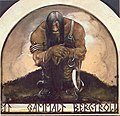John Bauer (illustrator): Difference between revisions
No edit summary |
|||
| Line 59: | Line 59: | ||
== External links == |
== External links == |
||
{{Commons|John Bauer}} |
{{Commons|John Bauer}} |
||
* [http://bauer.artpassions.net/] John Bauer Online Gallery at Art Passions |
|||
* [http://www.johnbauersmuseum.nu/ John Bauer Museum] {{sv icon}} |
* [http://www.johnbauersmuseum.nu/ John Bauer Museum] {{sv icon}} |
||
* [http://runeberg.org/jbauer/ Pictures by John Bauer] at [[Project Runeberg]] |
* [http://runeberg.org/jbauer/ Pictures by John Bauer] at [[Project Runeberg]] |
||
Revision as of 08:36, 3 February 2010
This article includes a list of references, related reading, or external links, but its sources remain unclear because it lacks inline citations. (September 2009) |
John Bauer | |
|---|---|
 | |
| Nationality | Swedish |
| Education | Royal Swedish Academy of Arts, Stockholm |
| Known for | Illustration Painting |

John Bauer (June 4, 1882 – November 20, 1918) was a Swedish painter and illustrator best known for his illustrations of Bland tomtar och troll (Among Gnomes and Trolls). Princess Tuvstarr and the Fishpond (named after Carex cespitosa), painted in 1913, is perhaps Bauer's most notable work.[1]
Biography
John Bauer was born and raised in Jönköping with his two brothers and sister, Anna Bauer, whose early death at 13 had a profound effect on John and his brothers. Living in an apartment situated above their father's charcuterie, he was always given to sketching and drawing. At sixteen, he set off for Stockholm to study art, and after two years he entered the Royal Swedish Academy of Arts.[2]
At the academy he met Esther Ellquist, whom he would marry in December 1906. Together they embarked on a two-year long trip to Germany and Italy to study art (1908-1910). Bauer's wife became the model for many of Bauer's paintings, most notably The Fairy Princess in 1905.
Bauer suffered from depression and self-doubts. By 1918 his marriage was falling apart, divorce was being discussed, and the world was at war. John and Esther, and their two-year old son, Bengt or Putte, were on their way to a new home in Stockholm, where John hoped for spiritual renewal and a new life for himself and his family. In the wake of the recent well-publicized train accident of Getå, John booked their return to Stockholm on a ferry, the Per Brahe steamer. John Bauer died in the shipwreck of Per Brahe along with Ester and Bengt.[3]
Artistry
Bauer's early work was influenced to a large extent by Albert Engström and Carl Larsson, two contemporaries and influential painters. Bauer's first major work was commissioned in 1904, when he was asked to illustrate a book on Lappland. It was not until 1907 that he would become known for his illustrations of Bland tomtar och troll, the yearly fairy tale book, in which his most highly acclaimed works would be published in the 1912-1915 editions.
Bauer also produced a fresco, Den helige Martin (The Holy Martin), which can be seen in the Odd Fellows lodge in Nyköping. Bauer's themes can be found in later works by the illustrators Arthur Rackham, Sulamith Wülfing, Kay Nielsen, Brian Froud and Rebecca Guay.
Modern day influence
- On the 100-year anniversary of the birth of John Bauer, the Swedish postal service made three, and later in 1997 four stamps with motifs from Bland tomtar och troll.
- A Scandinavian franchise of private schools has derived its name and some themes from John Bauer, naming its classes after his characters, for example.
- He is mentioned in Neil Gaiman’s comic book series The Sandman.
- The visual look of the motion picture The Dark Crystal, by Jim Henson and Frank Oz was inspired by the art of John Bauer.
- Norwegian Artist Mortiis uses the art of John Bauer on his Ambient albums.
Gallery
-
Trolls and Princess Tuvstarr
-
Tyr and Fenrir
-
Winter tales about the Yule Goat
-
Good evening, old man!
-
An old mountain troll
References
- ^ Biography of John Bauer, Illustrator
- ^ The John Bauer Museum
- ^ Getåolyckan 1918, Accessed on July 23, 2006 Swedish
Other Sources
- Helen Agrenius, The Artist John Bauer And His World (1996)
- Gunnar Lindqvist, John Bauer (1979)
- Anna Nilsson, John Bauer: Bland tomtar och troll(1999)
- Harald Schiller, John Bauer Sagotecknaren (1935)
External links
- [1] John Bauer Online Gallery at Art Passions
- John Bauer Museum Template:Sv icon
- Pictures by John Bauer at Project Runeberg





